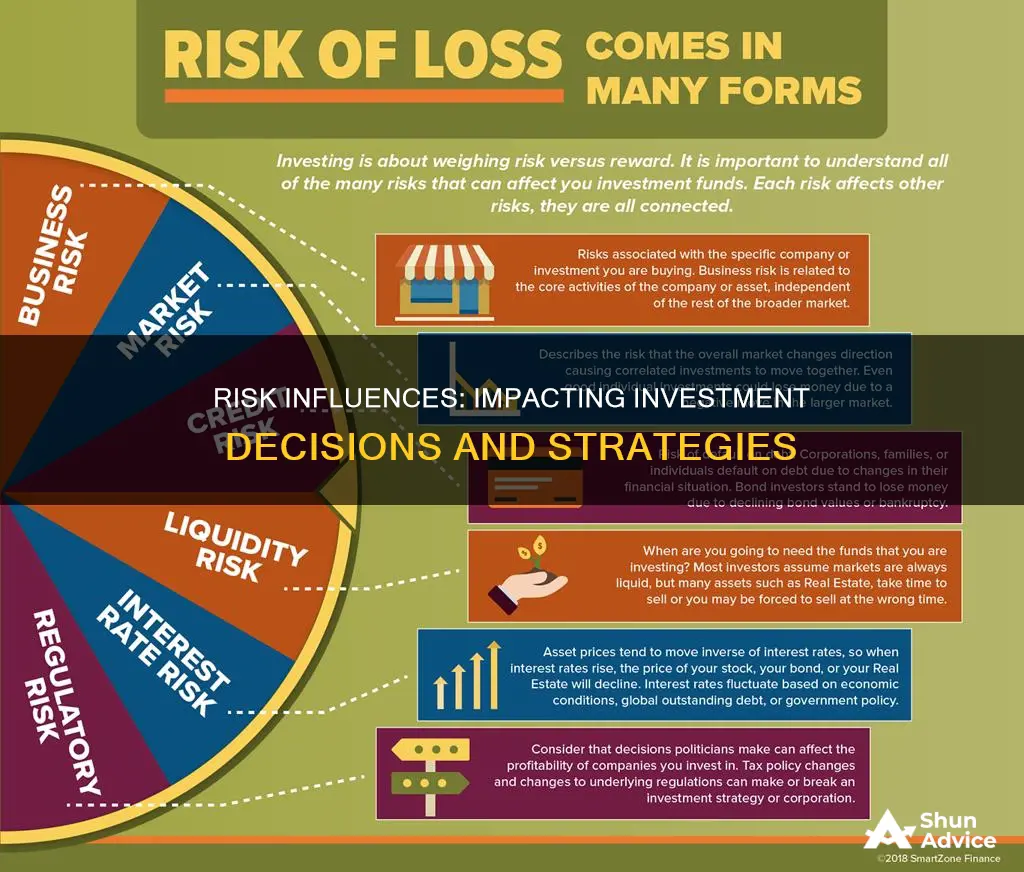
Risk is inherent in any investment, and it's important to understand the different types of risks that can influence investment outcomes. Financial risk can be broadly categorised into two types: systematic risk and unsystematic risk. Systematic risk, also known as market risk, affects the entire economic market or a large portion of it and is challenging to mitigate through portfolio diversification. Unsystematic risk, on the other hand, is specific to a particular industry or company and can be mitigated through diversification strategies.
Within these broad categories, there are several specific types of risk that investors should be aware of. These include market risk, credit risk, liquidity risk, operational risk, event risk, and more. Each type of risk can impact the value and performance of investment assets in various ways, and understanding these risks is crucial for making informed investment decisions.
Additionally, it's important to consider an investor's risk tolerance, which is influenced by factors such as age, income, financial goals, and investment timeline. Different investors will have different risk appetites, and it's essential to assess this before determining the appropriate investment strategy.
| Characteristics | Values |
|---|---|
| Type | Systematic or Unsystematic |
| Sub-types | Interest rate, market, reinvestment rate, purchasing power/inflation, currency, business, financial, credit, downgrade, liquidity and marketability, event, equity, interest rate, currency, concentration, credit, reinvestment, inflation, time horizon, longevity, foreign investment |
| Definition | Possibility of losing money on an investment; probability that the actual return will differ from the expected return; variability of returns |
| Risk-return tradeoff | Higher risk = higher potential returns |
What You'll Learn

Market Risk
- Equity Risk: This type of financial risk is associated with share market investments. The market price of equity shares can fluctuate based on various factors that affect their demand and supply. Equity risk refers to the possibility of losing investment value due to a significant drop in the market price of shares caused by market or political events.
- Interest Rate Risk: Interest rates in a market can fluctuate due to factors such as inflationary pressures. If a central bank raises interest rates to combat inflation, the market value of debt securities like bonds will drop as newly issued bonds become more attractive. This may force investors to sell older bonds with lower interest rates at a discount.
- Currency Risk: Currency risk, also known as exchange rate risk, is a factor when investing in foreign markets. The value of investments can change based on fluctuations in exchange rates between the domestic and foreign currencies.
- Liquidity Risk: Liquidity risk relates to an investor's ability to convert their investment into cash. It is the risk of not finding a market for securities, limiting the investor's ability to buy or sell when desired. Liquidity risk may arise when there are limited buyers in the market, potentially forcing investors to sell their assets at a loss. It can also occur when assets cannot be easily liquidated due to lock-in periods or early withdrawal penalties.
- Concentration Risk: Concentration risk refers to the possibility of loss when investing in only one security or asset class. In such cases, investors risk losing their entire investment if the market value of the selected security declines.
Equity Delivery Investments: Understanding Long-Term Stock Market Strategies
You may want to see also

Credit Risk
Credit rating agencies, such as Standard & Poor's, Fitch Ratings, and Moody's, evaluate the credit risks of bond issuers and then rate them. These ratings help investors understand the level of risk associated with a particular bond. Bonds with a lower chance of default are considered investment-grade, while those with a higher chance of default are considered high-yield or junk bonds.
Strategic Investment Portfolio: Corporations' Key Criteria
You may want to see also

Liquidity Risk
Effective liquidity risk management is crucial for financial stability and involves ensuring the availability of sufficient cash, liquid assets, and accessible borrowing lines to meet both expected and unexpected liquidity needs. Banks and financial institutions are often guided by regulatory frameworks, such as Basel III, which enforce stringent liquidity standards to safeguard depositor interests.
For individuals, liquidity risk management involves maintaining a reasonable budget, living within one's means, and having an emergency fund to cover living expenses for several months. Additionally, diversifying investments and ensuring access to liquid assets or credit facilities to meet unexpected financial needs are important strategies to mitigate liquidity risk.
Asset Managers: Brokers or Advisors?
You may want to see also

Operational Risk
The sources of operational risk are diverse and can include technological issues, employee mistakes, or malicious activities such as fraud. For example, a company's computer system may fail due to a power outage or cyberattack, disrupting its ability to conduct business. Similarly, human errors, such as data entry mistakes or incorrect financial reporting, can lead to significant financial losses. Fraud and other unethical activities by employees or external parties can also result in financial damage and a loss of reputation for the company.
To manage operational risk effectively, companies need to implement robust internal controls, processes, and systems. This includes establishing clear guidelines, policies, and procedures to minimise the likelihood of errors or fraudulent activities. Additionally, regular training and oversight can help employees identify potential risks and take appropriate actions to mitigate them.
Another critical aspect of operational risk management is business continuity planning. Companies should develop contingency plans to ensure that operations can continue during unexpected events, such as natural disasters or cyber-attacks. This involves identifying potential risks, developing response strategies, and testing the plans through simulations or tabletop exercises.
By proactively addressing operational risks, companies can minimise financial losses, maintain business continuity, and protect their reputation. Effective operational risk management also enables companies to make more informed decisions, allocate resources efficiently, and build resilience against unforeseen events.
In summary, operational risk is an inherent part of running a business and can have significant financial implications. By implementing robust internal controls, processes, and systems, companies can effectively manage operational risks and create a more stable and resilient organisation.
Home Equity Investment: Point-by-Point Guide to Success
You may want to see also

Event Risk
- Major tax or regulatory changes
- Changes to a company's capital structure, such as through a merger or buyout
- Disclosure of fraud or other significant misdeeds
- Negative media attention relating to a harmful or dangerous product
- Any other major, unexpected event, whether internal or external to the company
Unsystematic risk can be reduced through diversification. However, it is worth noting that systematic risk—which affects entire markets or large portions of markets—cannot be mitigated through diversification.
Angel Investing in India: Understanding the Basics
You may want to see also
Frequently asked questions
Investment risk refers to the degree of uncertainty inherent in an investment decision. There are no guarantees when investing, and the possibility of losing money is always present. The higher the risk, the higher the potential for both gains and losses.
There are two broad categories of investment risk: systematic risk and unsystematic risk. Systematic risk, also known as market risk, affects the entire market and cannot be mitigated through portfolio diversification. Unsystematic risk, on the other hand, is specific to a particular company or industry and can be reduced through diversification strategies. Examples of systematic risk include market risk, interest rate risk, inflation risk, and currency risk. Unsystematic risk includes business risk, financial risk, credit risk, and liquidity risk.
The time horizon is a key factor in determining an investor's risk tolerance. Generally, a longer time horizon allows for a higher risk appetite as there is more time to recover from potential losses. Conversely, a shorter time horizon may require a more conservative investment strategy to avoid potential short-term losses.
Risk tolerance refers to an investor's comfort level with taking on risk, while risk capacity is the amount of financial risk one can realistically take on given their financial situation. Both factors are crucial in determining the appropriate risk level for an investment portfolio.







